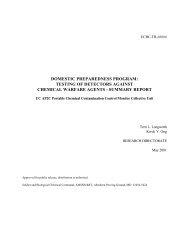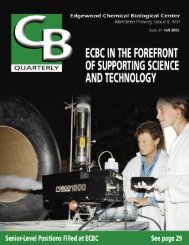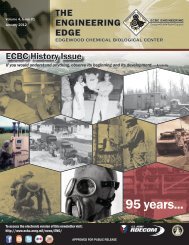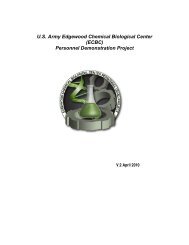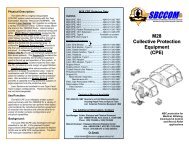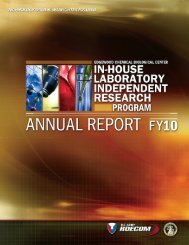(FFPE) with Self-Contained Breathing Apparatus (SCBA) for Rescue
(FFPE) with Self-Contained Breathing Apparatus (SCBA) for Rescue
(FFPE) with Self-Contained Breathing Apparatus (SCBA) for Rescue
You also want an ePaper? Increase the reach of your titles
YUMPU automatically turns print PDFs into web optimized ePapers that Google loves.
Agent<br />
Name and<br />
Symbol<br />
Sarin (GB)<br />
Soman<br />
(GD)<br />
VX<br />
Lewisite<br />
(L)<br />
Mustard<br />
(HD)<br />
Agent<br />
Class<br />
Nerve<br />
Blister<br />
Odor Potential Vapor Exposure Symptoms (Immediacy 1 ,<br />
Exposure Route, Exposure Severity)<br />
No<br />
Significant<br />
Odor<br />
Fruity,<br />
Camphor<br />
No<br />
Significant<br />
Odor<br />
Geraniums<br />
(immediate, eye contact effects)<br />
Pinpointing of pupils, blurred or dimmed vision, eye<br />
pain, headache;<br />
(delayed, skin contact effects)<br />
Increased local sweating, tremors (mild exposure)<br />
Vomiting, nausea, headache (moderate exposure)<br />
Convulsions, diarrhea, loss of consciousness, death<br />
(severe exposure);<br />
(delayed, inhalation effects)<br />
Vomiting, nausea, headache, convulsions, diarrhea,<br />
loss of consciousness, death<br />
(immediate, skin contact effects)<br />
Pain, irritation, burn<br />
(slightly delayed, skin contact effect)<br />
Blisters<br />
Garlic-like No immediate 2<br />
1<br />
2<br />
Dependent on exposure rate and total dosage<br />
Skin reddening and blisters generally are delayed by 4 to 18 hours after exposure<br />
Table 1. Chemical Agent Vapor Odors and Exposure Symptoms<br />
At normal indoor temperatures, chemical agents may be disseminated as a liquid, aerosol,<br />
and/or vapor. These dissemination <strong>for</strong>ms effectively create a continuum of mass sizes.<br />
Small aerosols can remain suspended in air <strong>for</strong> long times and are removed from<br />
enclosures by ventilation, as are vapors. Aerosol droplets, both liquid and solid, can<br />
deposit on surfaces and become skin contact hazards as well as sources <strong>for</strong> evaporation<br />
and re-aerosolization. Vapors can adsorb onto surfaces and subsequently offgas as vapor.<br />
This report provides estimations of the vapor hazard potentially faced by first responders.<br />
It does not address aerosol or liquid hazards. However, aerosol testing by SBCCOM<br />
has shown that new PBI turnout gear offers significantly better protection against<br />
chemical agent aerosols than chemical agent vapors. There<strong>for</strong>e, vapor is a greater hazard<br />
to first responders. However, when entering an area contaminated <strong>with</strong> liquid chemical<br />
agent, contact <strong>with</strong> liquid must be avoided.<br />
3



